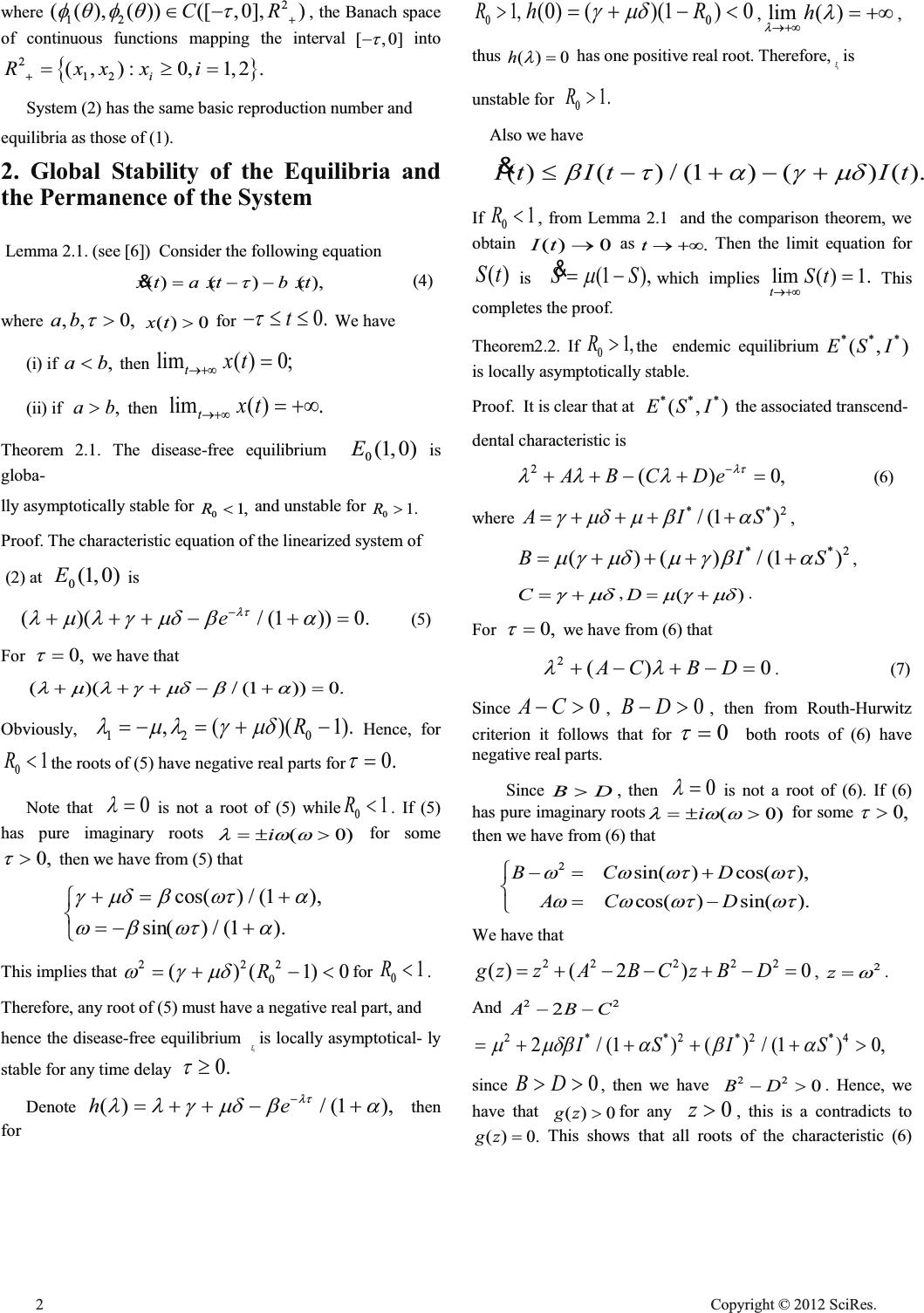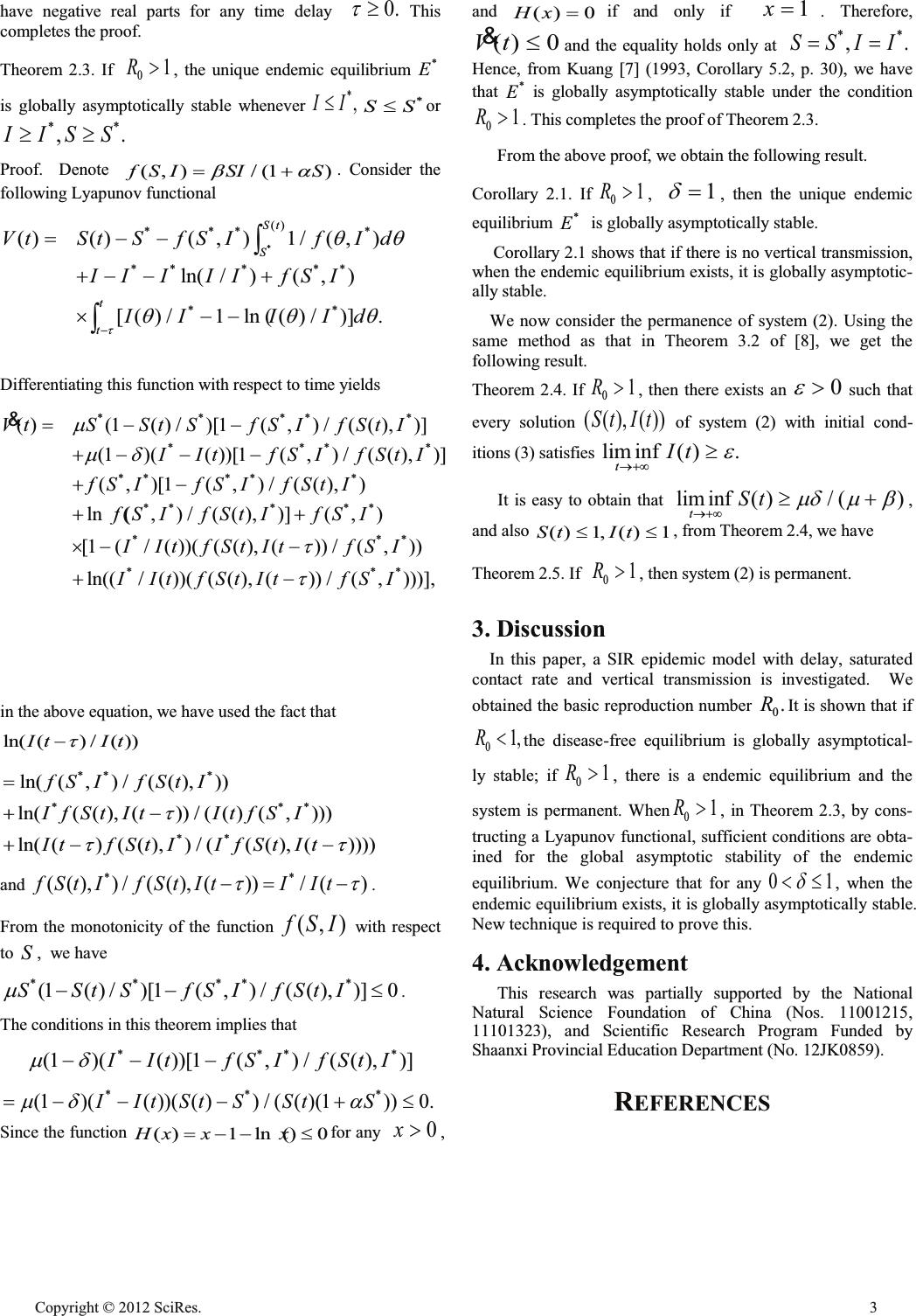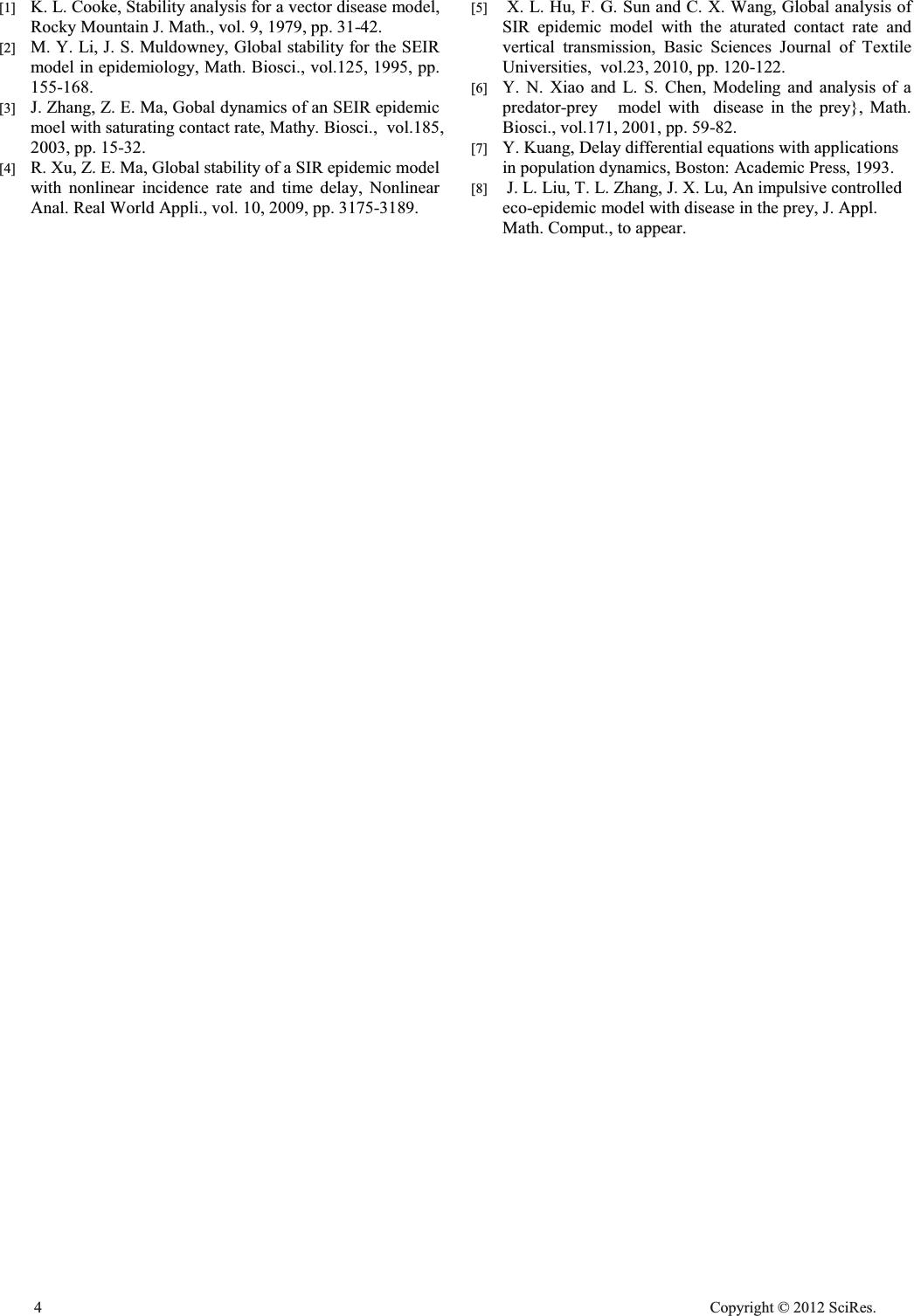Paper Menu >>
Journal Menu >>
 Global stability for delay SIR epidemic model with vertical transmission Junli Liu School of Science Xi'an Polytechnic University Xi'an, China ztlljl2008@yahoo.com.cn Tailei Zhang School of Mathematics and Statistics Xi'an Jiaotong University Xi'an, China Abstract—A SIR epidemic model with delay, saturated contact rate and vertical transmission is considered. The basic reproduction number 0 R is calculated. It is shown that this number characterizes the disease transmission dynamics: if 0 1R , there only exists the disease-free equilibrium which is globally asymptotically stable; if 0 1R! , there is a unique endemic equilibrium and the disease persists, sufficient cond- itions are obtained for the global asymptotic stability of the endemic equilibrium. Keywords- delay; vertical transmission; saturated contact rate; global asymptotic stability; permanence 1. Introduction In [1], Cooke formulated an SIR model with time delay 1 2 3 ()() ()(), ()() ()() (), () ()(), StStIt St It StItIt Rt ItRt EWP EWPJ JP / ° ® ° ¯ & & & where ()St denote the number of susceptibles, ()It the number of infectives and ()Rt the number of the removed. / is the recruitment rate. The force of infection at time t is given by () ()StIt EW . E is the average number of contacts per infective per day and 0 W ! is a fixed time during which the infectious agents develop in the vector, and it is only after that time that the infected vector can infect a susceptible human. 123 ,, PPP are positive constants repre- senting the death rates of susceptibles, infectives, and recovered, respectively. J is the recovery rate of infectives. Incidence rate plays an important role in the modelling of epidemic dynamics. The bilinear incidence rate SI E and the standard incidence rate /SI N E are mostly used. Different incidence rate have been used recently, such as pq SI E [2], () /NSI N E [3], /(1 )SI I ED [4]. Hu et al [5] studied an SIR epidemic model with saturation incidence rate and vertical transmission as follows /(1)(1 )(1 ), /(1)()( ). SSI SSI ISI SIt EDPPG EDPGJ ° ® ° ¯ & & (1) In model (1), it is assumed that the total population is unity, i.e. 1SI R , 0 P ! is the birth rate (or death rate), /(1 )SS ED (0,0) ED !t is the saturation inci- dence rate, 0 J ! is the recovery rate, 1 G (0 1) G d is the proportion of the vertical transmission. For system (1), they obtained the disease-free equilibrium 0 (1, 0)E . The basic reproduction for (1) is 0/ [(1)()]R EDJPG . If 0 1R! , (1) has a unique endemic equilibrium *** (,)ESI with *()/[()],S JPG EDJPG Also, in [5], it is proved when 0 1,Rd 0 E is globally asym- ptotically stable; when 01, D dd * E is globally asymptotic- ally stable. Motivated by the works [1] and [5], we now consider the delay effect and formulate the following model ()/(1 )(1)(1), ()/(1 )()(). SSItS SI IS ItSI t EW DPPG EW DPGJ ° ® ° ¯ & & (2) The initial condition of delay differential equations (2) is given as 12 ()()0,()() 0,[,0],SI TITTITT W ! ! (3) * [(1)( )]/[()(())].I PEDJPG JPEDJPG Open Journal of Applied Sciences Supplement:2012 world Congress on Engineering and Technology Cop y ri g ht © 2012 SciRes.1  where 2 12 ((), ())([,0],)CR IT ITW , the Banach space of continuous functions mapping the interval [,0] W into ` ^ 2 12 (, ):0,1,2. i Rxxxi t System (2) has the same basic reproduction number and equilibria as those of (1). 2. Global Stability of the Equilibria and the Permanence of the System Lemma 2.1. (see [6]) Consider the following equation ()( )(),xt axtbxt W & (4) where ,, 0,ab W ! () 0xt! for 0.t W dd We have (i) if ,ab then lim( )0; t xt of (ii) if ,ab! then lim( ). t xt of f Theorem 2.1. The disease-free equilibrium 0 (1, 0)E is globa- lly asymptotically stable for 0 1,R and unstable for 01.R! Proof. The characteristic equation of the linearized system of (2) at 0 (1, 0)E is ()(/ (1))0.e OW OPOJPGE D (5) For 0, W we have that ()(/ (1))0. OPOJPGE D Obviously, 12 0 ,( )(1).R OPOJPG Hence, for 0 1R the roots of (5) have negative real parts for 0. W Note that 0 O is not a root of (5) while 0 1R . If (5) has pure imaginary roots (0)i OZZ r! for some 0, W ! then we have from (5) that cos() /(1), sin()/ (1). JPGE ZWD ZEZWD ® ¯ This implies that 222 0 ()(1)0R ZJPG for 0 1R . Therefore, any root of (5) must have a negative real part, and hence the disease-free equilibrium 0 E is locally asymptotical- ly stable for any time delay 0. W t Denote ()/(1 ),he OW OOJPGE D then for 0 1,R! 0 (0) ()(1)0hR JPG , lim( )h O O of f , thus () 0h O has one positive real root. Therefore, 0 E is unstable for 01.R! Also we have ()()/(1)()().It ItIt EW DJPG d & If 0 1R , from Lemma 2.1 and the comparison theorem, we obtain () 0It o as .tof Then the limit equation for ()St is (1 ),SS P & which implies lim()1. t St of This completes the proof. Theorem2.2. If 01,R! the endemic equilibrium *** (,)ESI is locally asymptotically stable. Proof. It is clear that at *** (,)ESI the associated transcend- dental characteristic is 2 ()0,ABCDe OW OO O (6) where **2 /(1 )AIS JPGPE D , **2 ()()/(1)BIS PJPGPJ ED , C JPG , ()D PJ PG . For 0, W we have from (6) that 2() 0ACB D OO . (7) Since 0AC! , 0BD! , then from Routh-Hurwitz criterion it follows that for 0 W both roots of (6) have negative real parts. Since BD! , then 0 O is not a root of (6). If (6) has pure imaginary roots (0)i OZZ r! for some 0, W ! then we have from (6) that 2 sin( )cos( ), cos( )sin( ). BC D AC D ZZ ZWZW ZZ ZWZW ® ¯ We have that 22222 ()(2)0gzzAB CzBD , 2 z Z . And 22 2ABC 2**2 *2*4 2/ (1)()/(1)0,ISIS PPGED ED ! since 0BD!! , then we have 22 0BD! . Hence, we have that () 0gz! for any 0z! , this is a contradicts to () 0.gz This shows that all roots of the characteristic (6) 2 Cop y ri g ht © 2012 SciRes.  have negative real parts for any time delay 0. W t This completes the proof. Theorem 2.3. If 01R! , the unique endemic equilibrium * E is globally asymptotically stable whenever *,IId * SSd or ** ,.IISStt Proof. Denote (,)/(1 )fSI SIS ED . Consider the following Lyapunov functional * () *** * ** * ** ** ()()(, )1/(,) ln( /)(,) [( )/1ln(( )/)]. St S t t VtStSfSIfId II IIIfSI IIIId W TT TTT u ³ ³ Differentiating this function with respect to time yields ***** **** ** *** *** ** *** * ()(1()/)[1( , )/((),)] (1)(())[1(,)/(( ),)] (,)[1 (,)/((),) ln ((,)/((),)](, ) [1(/( ))((( ),())/(,)) ln((/( ))(( VtSStSf SIfStI IItfSI fStI fS IfS IfStI fS IfStIfS I IItfStItfSI IItf P PG W u & ** (),()) /(,)))],StItf SI W in the above equation, we have used the fact that ln(() /())It It W ** * *** ** ln((,)/((),)) ln((( ),())/(( )(,))) ln(()(( ),)/((( ),()))) fSIfSt I I f StItIt f SI Itf StII f StIt W WW and ** ((),)/((),( ))/( )fSt IfStItIIt WW . From the monotonicity of the function (, )fSI with respect to S , we have **** * (1() /)[1(,) /((),)]0SStSfSIfStI P d . The conditions in this theorem implies that **** (1)(())[1(,)/(( ),)]IItfSI fStI PG *** (1)(())(( ))/(()(1))0.IItStSStS PG D d Since the function ()1 ln()0Hxxx d for any 0x! , and () 0Hx if and only if 1x . Therefore, () 0Vt d & and the equality holds only at ** ,.SSII Hence, from Kuang [7] (1993, Corollary 5.2, p. 30), we have that * E is globally asymptotically stable under the condition 0 1R! . This completes the proof of Theorem 2.3. From the above proof, we obtain the following result. Corollary 2.1. If 0 1R! , 1 G , then the unique endemic equilibrium * E is globally asymptotically stable. Corollary 2.1 shows that if there is no vertical transmission, when the endemic equilibrium exists, it is globally asymptotic- ally stable. We now consider the permanence of system (2). Using the same method as that in Theorem 3.2 of [8], we get the following result. Theorem 2.4. If 01R! , then there exists an 0 H ! such that every solution ((),())St It of system (2) with initial cond- itions (3) satisfies lim inf(). t It H of t It is easy to obtain that lim inf()/() t St PGP E of t , and also () 1,() 1StItdd , from Theorem 2.4, we have Theorem 2.5. If 01R! , then system (2) is permanent. 3. Discussion In this paper, a SIR epidemic model with delay, saturated contact rate and vertical transmission is investigated. We obtained the basic reproduction number 0 .R It is shown that if 0 1,R the disease-free equilibrium is globally asymptotical- ly stable; if 01R! , there is a endemic equilibrium and the system is permanent. When 01R! , in Theorem 2.3, by cons- tructing a Lyapunov functional, sufficient conditions are obta- ined for the global asymptotic stability of the endemic equilibrium. We conjecture that for any 01 G d , when the endemic equilibrium exists, it is globally asymptotically stable. New technique is required to prove this. 4. Acknowledgement This research was partially supported by the National Natural Science Foundation of China (Nos. 11001215, 11101323), and Scientific Research Program Funded by Shaanxi Provincial Education Department (No. 12JK0859). REFERENCES Cop y ri g ht © 2012 SciRes.3  [1] K. L. Cooke, Stability analysis for a vector disease model, Rocky Mountain J. Math., vol. 9, 1979, pp. 31-42. [2] M. Y. Li, J. S. Muldowney, Global stability for the SEIR model in epidemiology, Math. Biosci., vol.125, 1995, pp. 155-168. [3] J. Zhang, Z. E. Ma, Gobal dynamics of an SEIR epidemic moel with saturating contact rate, Mathy. Biosci., vol.185, 2003, pp. 15-32. [4] R. Xu, Z. E. Ma, Global stability of a SIR epidemic model with nonlinear incidence rate and time delay, Nonlinear Anal. Real World Appli., vol. 10, 2009, pp. 3175-3189. [5] X. L. Hu, F. G. Sun and C. X. Wang, Global analysis of SIR epidemic model with the aturated contact rate and vertical transmission, Basic Sciences Journal of Textile Universities, vol.23, 2010, pp. 120-122. [6] Y. N. Xiao and L. S. Chen, Modeling and analysis of a predator-prey model with disease in the prey}, Math. Biosci., vol.171, 2001, pp. 59-82. [7] Y. Kuang, Delay differential equations with applications in population dynamics, Boston: Academic Press, 1993. [8] J. L. Liu, T. L. Zhang, J. X. Lu, An impulsive controlled eco-epidemic model with disease in the prey, J. Appl. Math. Comput., to appear. 4 Cop y ri g ht © 2012 SciRes. |

